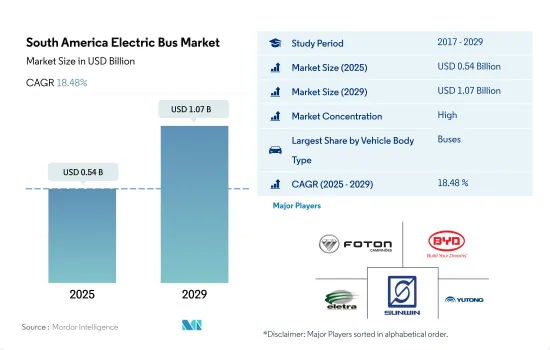Need help finding what you are looking for?
Contact Us
PUBLISHER: Mordor Intelligence | PRODUCT CODE: 1693613

PUBLISHER: Mordor Intelligence | PRODUCT CODE: 1693613
South America Electric Bus - Market Share Analysis, Industry Trends & Statistics, Growth Forecasts (2025 - 2030)
PUBLISHED:
PAGES: 196 Pages
DELIVERY TIME: 2-3 business days
SELECT AN OPTION
The South America Electric Bus Market size is estimated at 0.54 billion USD in 2025, and is expected to reach 1.07 billion USD by 2029, growing at a CAGR of 18.48% during the forecast period (2025-2029).

The adoption of electric buses in South American countries is uneven but promising, indicating a regional dedication to cleaner public transportation
- South America has the highest use of buses per person globally. With a growing Bus Rapid Transit System, nearly 19 million passengers have been identified as traveling through BRT services across several cities in the region. To support this growing demand, many municipalities in the region have started working on expanding public transit options into less-served areas, where cleaner buses may play a vital role in filling the gaps.
- Several countries in the region are adopting measures to meet the rising demand for electric buses. In August 2022, Marcopolo announced the series production of its first electric bus with its own chassis. Marcopolo will produce 30 of the new Attivi electric buses that will be deployed in Brazil and later to other countries. Such activities are expected to attract customers, which further will increase the demand for electric buses across the region.
- Various states in various countries across the region are planning to deploy electric buses to increase sustainable transportation and cut down on carbon emissions. In December 2022, Sao Paulo, Brazil, announced a ban on diesel and planned to deploy 2600 electric buses by the end of 2024. The deployment of the electric buses will boost the electric bus industry in Brazil, which further will enhance electric mobility across the region.
South America Electric Bus Market Trends
Surging demand and government incentives propel South America's electric vehicle market
- Countries like Brazil and Argentina in South America show significant potential in the automobile market. The South American vehicle industry has witnessed notable growth in recent years. Notably, the region has seen a rising demand for electric vehicles (EVs), especially in the passenger car segment. This surge can be attributed to factors like heightened awareness, growing environmental concerns, and governmental initiatives promoting EV adoption. In fact, EV sales in the region saw a notable increase, growing by 17.95% in 2022 compared to 2021.
- South America, with its diverse markets, is poised for a surge in electric vehicles. Brazil, in particular, is eyeing a shift toward electric buses, driven by its focus on renewable power generation and its abundant reserves of niobium and lithium, crucial for EV battery development. A significant move in this direction came in December 2022 when Sao Paulo banned diesel bus purchases and announced plans to deploy 2600 electric buses by 2024-end. Similar trends in other South American nations are expected to drive vehicle electrification from 2024 to 2030.
- Government policies and incentive programs across South American nations are set to be key drivers for vehicle electrification in the region. Tax benefits, for instance, are playing a pivotal role. Colombia's government, for instance, is leveraging incentives and subsidies with an ambitious target of putting 600,000 EVs on its roads by 2030, aiming to tackle carbon emissions. With similar initiatives anticipated in other South American countries, the sales of EVs are expected to witness a surge from 2024 to 2030.
South America Electric Bus Industry Overview
The South America Electric Bus Market is fairly consolidated, with the top five companies occupying 92.46%. The major players in this market are Beiqi Foton Motor Co. Ltd., Byd Auto Industry Company Limited, ELETRA Industrial LTDA, Shanghai Sunwin Bus Corporation.Ltd. and Zhengzhou Yutong Bus Co. Ltd. (sorted alphabetically).
Additional Benefits:
- The market estimate (ME) sheet in Excel format
- 3 months of analyst support
Product Code: 92997
TABLE OF CONTENTS
1 EXECUTIVE SUMMARY & KEY FINDINGS
2 REPORT OFFERS
3 INTRODUCTION
- 3.1 Study Assumptions & Market Definition
- 3.2 Scope of the Study
- 3.3 Research Methodology
4 KEY INDUSTRY TRENDS
- 4.1 Population
- 4.2 GDP Per Capita
- 4.3 Consumer Spending For Vehicle Purchase (cvp)
- 4.4 Inflation
- 4.5 Interest Rate For Auto Loans
- 4.6 Shared Rides
- 4.7 Impact Of Electrification
- 4.8 EV Charging Station
- 4.9 Battery Pack Price
- 4.10 New Xev Models Announced
- 4.11 Fuel Price
- 4.12 Oem-wise Production Statistics
- 4.13 Regulatory Framework
- 4.14 Value Chain & Distribution Channel Analysis
5 MARKET SEGMENTATION (includes market size in Value in USD and Volume, Forecasts up to 2029 and analysis of growth prospects)
- 5.1 Fuel Category
- 5.1.1 BEV
- 5.1.2 HEV
- 5.2 Country
- 5.2.1 Argentina
- 5.2.2 Brazil
- 5.2.3 Rest-of-South America
6 COMPETITIVE LANDSCAPE
- 6.1 Key Strategic Moves
- 6.2 Market Share Analysis
- 6.3 Company Landscape
- 6.4 Company Profiles
- 6.4.1 Anhui Ankai Automobile Co. Ltd.
- 6.4.2 Beiqi Foton Motor Co. Ltd.
- 6.4.3 Byd Auto Industry Company Limited
- 6.4.4 ELETRA Industrial LTDA
- 6.4.5 Higer Bus Company Ltd.
- 6.4.6 King Long United Automotive Industry Co. Ltd.
- 6.4.7 Shanghai Sunwin Bus Corporation.Ltd.
- 6.4.8 Volvo Group
- 6.4.9 Zhengzhou Yutong Bus Co. Ltd.
- 6.4.10 Zhongtong Bus Holding Co. Ltd.
7 KEY STRATEGIC QUESTIONS FOR VEHICLES CEOS
8 APPENDIX
- 8.1 Global Overview
- 8.1.1 Overview
- 8.1.2 Porter's Five Forces Framework
- 8.1.3 Global Value Chain Analysis
- 8.1.4 Market Dynamics (DROs)
- 8.2 Sources & References
- 8.3 List of Tables & Figures
- 8.4 Primary Insights
- 8.5 Data Pack
- 8.6 Glossary of Terms
Have a question?


SELECT AN OPTION
Have a question?


Questions? Please give us a call or visit the contact form.
